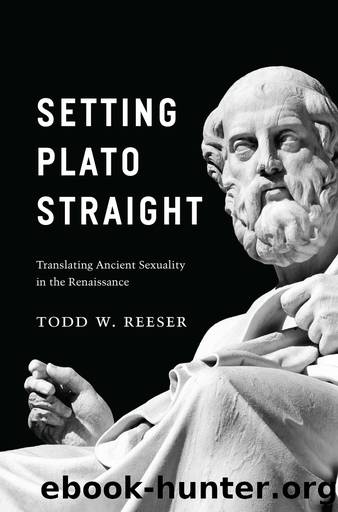Setting Plato Straight by Todd W. Reeser;

Author:Todd W. Reeser; [Reeser, Todd W.]
Language: eng
Format: epub
ISBN: 9780226307145
Publisher: University of Chicago Press
Published: 2015-12-14T06:00:00+00:00
This description has provoked much critical discussion about the image as a sign of Rabelaisâs marrying of Christian love and eros.38 But the question that interests me here is the relation of the image to same-sex eros, one that has been discussed by Carla Freccero. As she has suggested, the figure is indicative of a sexual ambiguity as the sex of the Platonic being is unclear.39 Indeed, the being is not described in the sexed terms that Plato uses but as âun corps humain.â The humanness in a story all about sexual orientations suggests ambiguity. Freccero points out that homoerotic linguistic games are embedded in the passage: âayant deux testes, lâune virée vers lâaultre, quatre bras, quatre piedz, et deux culzâ (27) may refer to âtestesâ in the normal sense of head but also of testes. The word âviréeâ [turned] may refer to a false etymological origin (vir, man), with a sense something like âmanned,â and the two âculzâ [rumps] may be a reference to sodomy.40 As Freccero writes, âReaders of this playful and playfully disguised text should not be surprised that such [same-sex] possibilities exist within the economy of a discourse so exclusively masculine in its thematic horizons.â41 The passage is ambiguous with respect to sex, but one possible meaning of the ambiguity is the very question of how Platonic same-sex male eros is interpreted or understood in the period. The emblem on Gargantuaâs forehead could be read as a marker or figure about Platonic eros, but it could also be commenting on how one reads that eros. In light of the Pauline motto, a reader may or may not read it as erotic, but its ambiguity may signify the effacement of sex or the effacement of the male sex. Christian âcharity,â as the words written on the image, might be read in this light as displacing sexed erosâor as having displaced sexed eros in previous readings of Platoâand since that charity is textual here, the larger point may be that rereading ancient eros in Aristophanesâs myth allegorizes the Renaissanceâs obsession with the effacement of the sexes or the neutralization of sex. Rabelais is calling attention to the configuring of the beings as unsexed humans. In this sense, the image corresponds to the prologueâs lesson about âinâ jokes and reading communities since the image can only refer to male-male eros in a Platonic vein for those in the know. The sexed ambiguity is closely tied to a sense in which the message of Aristophanesâs myth is not about God, manâs two lights (Ficino), or the biblical Creation myth (Le Roy), but about reading sex itself. As per the prologue, then, flesh and a Platonism tending toward immateriality exist together here as the message pertains and does not pertain to the flesh. The image may be exterior to the deeper meaning of Christian charity, and it is a result of reading convention.
In the end, I am suggesting that Rabelais is taking issue with Erasmusâs idea that communal friendship should define how the meaning of eros is made from ancient sources.
Download
This site does not store any files on its server. We only index and link to content provided by other sites. Please contact the content providers to delete copyright contents if any and email us, we'll remove relevant links or contents immediately.
The Power of Myth by Joseph Campbell & Bill Moyers(925)
Half Moon Bay by Jonathan Kellerman & Jesse Kellerman(911)
A Social History of the Media by Peter Burke & Peter Burke(882)
Inseparable by Emma Donoghue(844)
The Nets of Modernism: Henry James, Virginia Woolf, James Joyce, and Sigmund Freud by Maud Ellmann(739)
The Spike by Mark Humphries;(719)
A Theory of Narrative Drawing by Simon Grennan(707)
The Complete Correspondence 1928-1940 by Theodor W. Adorno & Walter Benjamin(704)
Ideology by Eagleton Terry;(659)
Bodies from the Library 3 by Tony Medawar(649)
Culture by Terry Eagleton(646)
World Philology by(645)
Farnsworth's Classical English Rhetoric by Ward Farnsworth(641)
A Reader’s Companion to J. D. Salinger’s The Catcher in the Rye by Peter Beidler(614)
Adam Smith by Jonathan Conlin(608)
High Albania by M. Edith Durham(592)
Game of Thrones and Philosophy by William Irwin(592)
Comic Genius: Portraits of Funny People by(581)
Monkey King by Wu Cheng'en(577)
